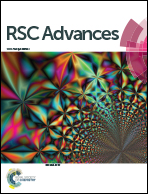Plasmonic nanoprobes based on the shape transition of Au/Ag core–shell nanorods to dumbbells for sensitive Hg-ion detection
Abstract
We report a sensitive and selective localized surface plasmon resonance (LSPR) nanoprobe for the detection of mercuric ions (Hg2+) using gold/silver core–shell nanorods as an optical nanosubstrate. Sulfide can quickly react with silver atoms to generate Ag2S at room temperature in the presence of oxygen. The transformation from Ag shell to Ag2S on the nanorod surface results in its LSPR absorption band shifting to a longer wavelength, which is attributed to their different refractive indices. Interestingly, the morphology also changed from a rod-like to dumbbell shape. However, in the presence of Hg2+, this morphology transformation is inhibited because the sulfide reacts with free Hg2+ prior to the Ag atoms. The amount of Ag2S reduced with the increasing concentration of Hg2+, and the absorption band shift was also decreased. According to this “rod-like to dumbbell or not” shape change, a sensitive and selective LSPR nanoprobe was established, assisted by UV-Vis absorption spectroscopy. The detection limit of this probe for Hg2+ was as low as 13 nM. The efficiency of this probe in complex samples was evaluated by the detection of Hg2+ in spiked water samples.



 Please wait while we load your content...
Please wait while we load your content...